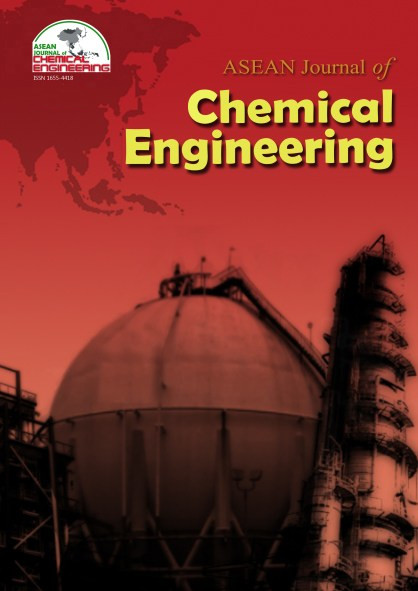Sulfuric Acid Resistance of Geopolymer Mortars from Co-combustion Residuals of Bamboo and Kaolin
Abstract
This study presents an investigation of the durability and microstructure of geopolymer mortars from co-combustion residuals of bamboo and kaolin when exposed to 5% sulfuric acid solution for 2, 4, and 6 weeks, respectively. Geopolymer mortars sized 5 x 5 x 5 cm were prepared from co-combustion residuals of bamboo and kaolin with alkaline activators, i.e. mixture of 10 N potassium hydroxide solution and sodium silicate solution, and cured at 60 oC in oven for 8 hours and then at room temperature for 28 days. Mortars from ordinary Portland cement were also prepared as control mortars. The parameters studied were visual appearance changes, mass changes, compressive strength changes, and microstructure changes. Microstructure changes were examined using Fourier transform infrared (FTIR) spectroscopy, X-ray diffraction (XRD), and scanning electron microscopy (SEM). The results revealed that geopolymer mortars showed better sulfuric acid resistance compared to ordinary Portland cement mortars in terms of lower mass loss and lower compressive strength loss.References
2. Allahverdi, A., and Skvara, F. (2000b). Acidic corrosion of hydrated cement based materials Part 2. -Kinetics of the phenomenon and mathematical models, Ceram.-Silik., 44(4), 152-160.
3. Allahverdi, A., and Skvara, F. (2005). Sulfuric acid attack on hardened paste of geopolymer cements Part 1. Mechanism of corrosion at relatively high concentrations, Ceram.-Silik., 49(4), 225-229.
4. Ariffin, M.A.M., Bhutta, M.A.R., Hussin, M.W., Tahir, M. M., and Aziah, N. (2013). Sulfuric acid resistance of blended ash geopolymer concrete, Constr. Build. Mater.,43, 80-86.
5. ASTM C109M. (2007). Standard test method for compressive strength of hydraulic cement mortars (using 2-in. or [50-mm] cube specimens), ASTM International, West Conshohocken, USA.
6. Bakharev, T. (2005). Resistance of geopolymer materialsto acid attack, Cem. Concr. Res.,35, 658-670.
7. Bernal, S.A., Rodríguez, E.D., de Gutiérrez, R.M., and Provis, J.L. (2012). Performance of alkali-activated slag mortars exposed to acids, J. Sustainable Cem.-Based Mater.,1(3), 138-151.
8. Bouguermouh, K., Bouzidi, N., Mahtout, L., Pérez-Villarejo, L., and Martínez-Cartas, M.L. (2017). Effect of acid attack on microstructure and composition of metakaolin-based geopolymers: The role of alkaline activator, J. Non-Cryst. Solids,463, 128-137.
9. Chukanov, N.V. (2014). Infrared spectra of mineral species: Extended library,vol. 1, Springer, Dordrecht, Netherlands.
10. Davidovits, J. (2008). Geopolymer: Chemistry and applications,2nd ed., Institut Géopolymère, Saint-Quentin, France.
11. Duxson, P., Fernández-Jiménez, A., Provis, J.L., Lukey, G.C., Palomo, A., and van Deventer, J.S.J. (2007). Geopolymer technology: The current state of the art, J. Mater. Sci.,42, 2917-2933.
12. Febrero, L., Granada, E., Patiño, D., Eguía, P., and Regueiro, A. (2015). A comparative study of fouling and bottom ash from woody biomass combustion in a fixed-bed small-scale boiler and evaluation of the analytical techniques used, Sustainability,7, 5819-5837.
13. Govindarajan, D., and Gopalakrishnan, R. (2011). Spectroscopic studies on Indian Portland cement hydrated with distilled water and sea water, Frontiers in Science, 1(1), 21-27.
14. Kim, Y.Y., Lee B.J., Saraswathy, V., and Kwon, S.J. (2014). Strength and durability performance of alkali-activated rice husk ash geopolymer mortar, Scientific World J.,2014, 1-10.
15. Lee, W.K.W., and van Deventer, J.S.J. (2002). The effects of inorganic salt contamination on the strength and durability of geopolymers, Colloids Surf. A Physicochem. Eng. Asp.,211, 115-126.
16. Llorente, M.J.F., Arocas, P.D., Nebot, L.G., and Garcia, J.E.C. (2008). The effect of the addition of chemical materials on the sintering of biomass ash, Fuel, 87(12), 2651-2658.
17. Purbasari, A., Samadhi, T.W., and Bindar, Y. (2016). Thermal and ash characterization of Indonesian bamboo and itspotential for solid fuel and waste valorization, Int. Journal of Renewable Energy Development, 5(2), 95-100.
18. Sata, V., Sathonsaowaphak, A., and Chindaprasirt, P. (2012). Resistance of lignite bottom ash geopolymer mortar to sulfate and sulfuric acid attack, Cem. Concr. Compos.,34, 700-708.
19. van Deventer, J.S.J., Provis, J.L., and Duxson, P. (2012). Technical and commercial progress in the adoption of geopolymer cement, Miner. Eng., 29,89-104.
Copyright holder for articles is ASEAN Journal of Chemical Engineering. Articles published in ASEAN J. Chem. Eng. are distributed under a Creative Commons Attribution-NonCommercial 4.0 International (CC BY-NC 4.0) license.
Authors agree to transfer all copyright rights in and to the above work to the ASEAN Journal of Chemical Engineering Editorial Board so that the Editorial Board shall have the right to publish the work for non-profit use in any media or form. In return, authors retain: (1) all proprietary rights other than copyright; (2) re-use of all or part of the above paper in their other work; (3) right to reproduce or authorize others to reproduce the above paper for authors’ personal use or for company use if the source and the journal copyright notice is indicated, and if the reproduction is not made for the purpose of sale.



